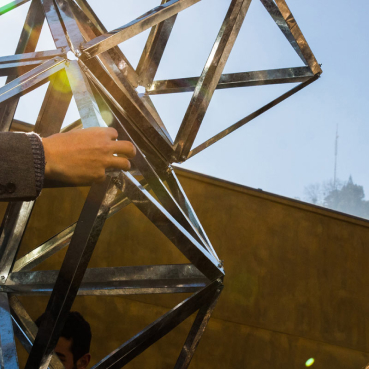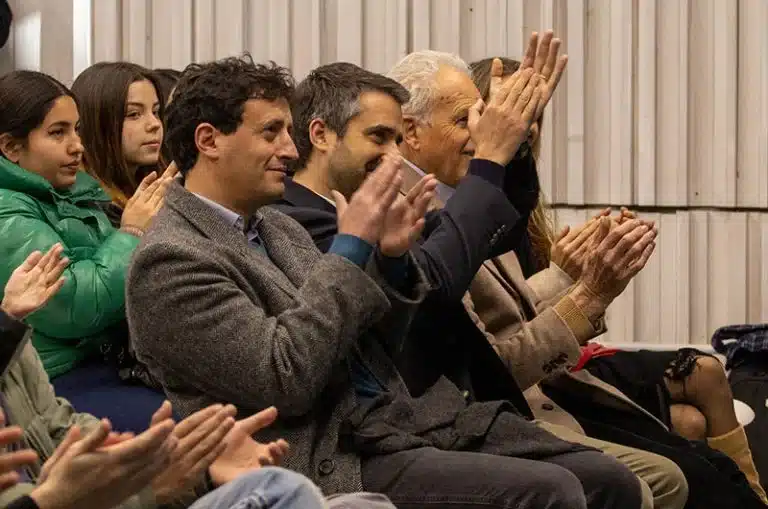In any case, the distinction between fiction and nonfiction isn’t the distinction between falsehood and truth. It’s as easy to lie with facts as it is with fictions—a tendentious selection of verifiable events can turn an ostensible report into a grotesque distortion. The problem with “Steve Jobs” isn’t its departures from facts about Jobs’s life that can be rapidly gleaned from a glance at Walter Isaacson’s biography of him. (Laura Bradley and Rick Tetzeli do the heavy lifting at Slate and Fast Company, respectively.) It’s the fact that the fictionalized elements of the movie don’t produce increased insight into Jobs, and don’t lead to a grasp of Jobs’s spirit in exchange for the reportorial letter of his life story.
The prime cause of every bio-pic isn’t informational; it’s moral and reflexive. Every bio-pic affirms, first, that it’s worth your while to know about this person’s life and, second, that there’s something about this person’s life that makes it extraordinary and exemplary, that transforms this person into a character equal to those of fiction. But the elements, qualities, achievements, or actions that make this person’s life exemplary and dramatic may not be immediately detectable from any particular moment that this person actually lived. To rival fiction, lives need to be transformed into fiction.
Yet the very notion of the bio-pic is at odds with dramatic form, because lives are untidy and unstrung, while dramas are orderly and organized. The details are what can make a life—its surprising reality—seem even more wondrous than a drama. But that sense of wonder isn’t the same as insight. There’s no bio-pic rule that dictates in advance which departures from the record are appropriate, which omissions are legitimate. The choices become a question of not violating the spirit of the character while not deforming a sense of the world.
The primary shortcoming of “Steve Jobs” is the simplistic reduction of Jobs, by the movie’s screenwriter, Aaron Sorkin, to a small set of facile diagnoses. I’m inclined to consider Sorkin the movie’s guiding artistic spirit. There’s nothing in the director Danny Boyle’s visual conception or dramatic organization of the film that distinguishes itself from Sorkin’s text—as, for instance, there is, profoundly, in David Fincher’s filming of Sorkin’s script for “The Social Network.” Boyle is so deferential to the script that he might as well have torn the pages from the script and pasted them on the screen.
Sorkin realizes his view primarily in three sections—one set in 1984, when Jobs (played by Michael Fassbender) launched the Macintosh; the second, in 1988, when, after being pushed out of Apple, he founded his own firm, NeXT; and then, in 1998, when he introduced the iMac—all of which are punctuated by flashbacks. In Sorkin’s view, because Jobs was adopted, he had a chip on his shoulder the size of Stonehenge and, having been the pawn of others’ will from the start, could not bear the thought of not being in control. But, because his girlfriend Chrisann Brennan’s pregnancy was something that he couldn’t control, because he had a daughter he didn’t want, with a woman he didn’t want to be bound to, he chose to repudiate his daughter Lisa, to challenge his paternity in court, and, when it was affirmed, to ridicule the decision in the press.
Seeking to control the situation—and Chrisann and Lisa—Jobs (as depicted in the movie) refused to treat them humanely, withholding his love from his daughter and his money from his ex. He may, more than a decade later, have come to admire Lisa’s intelligence and character, but he didn’t pay for her first semester at Harvard, because he wanted to control the way that Chrisann used the property and funds that he gave her.
Jobs, Sorkin suggests, didn’t want to be compelled to do anything that he didn’t want to do—and he didn’t want others to do anything he didn’t want them to do. He refused to relinquish control of his work, and so denied his collaborator Steve Wozniak his due recognition. He insisted that his computers be closed systems, denying users the ability to customize them and requiring that they be used only as he planned. He refused to acknowledge the company’s past successes—and those who had a hand in them—for fear of projecting the slightest doubt regarding the overwhelming superiority and necessity of his new product.
The great paradox that Sorkin offers is that Jobs created a machine that was meant to unleash creativity—but only on Jobs’s terms. In the movie, Jobs sees the five-year-old Lisa using MacPaint software, and he saves and cherishes her first computer art, not because it’s the one artifact of hers that’s in his possession or because it’s a major achievement but because it’s her primordial effort to make her mark within the frame that he created, her first try to fit her mind into his world, the world of his making.
Sorkin has an amazingly detailed imagination. He builds situations and scenes that enthrallingly and intricately construct Jobs’s subtle and farsighted maneuverings. Sorkin is a master of characters’ tactical manipulations in the interest of their stated strategies. “Steve Jobs” runs on two parallel tracks: one of business, in which smart people play each other and the system that binds them together, and one of personal life, regarding how people treat each other. Both tracks give rise to Sorkin’s familiar but endlessly enjoyable, quick-shifting dialogue, and the two tracks aren’t sealed off from each other. Sorkin lets the manipulations affect, and be affected by, human relations. Here, “personal” doesn’t mean “apart from business” but includes the part of business that involves its impact on the feelings and the well-being of others. (Joanna Hoffman, the marketing executive played by Kate Winslet, unfailingly and insistently brings her work with Jobs back to personal terms, as does the programmer Andy Hertzfeld, played by Michael Stuhlbarg.)
As Josh Rothman pointed out last week, Sorkin has little feel or concern for the creative sensibility that motivated Jobs to drive himself and others. (As for the problem of depicting genius in movies, it’s simple: it takes one to know one; all others either respect the wonder or get lucky.) Yet the movie nonetheless takes Jobs’s power very seriously; its very subject is the nature of the world that Steve Jobs brought about.
Sorkin’s failure to get close to Jobs’s creative side isn’t actually a failure; it’s built into Sorkin’s big idea about Jobs. Sorkin certainly depicts Jobs as a bringer of change—but a bringer of change for the worse. The movie’s view of Jobs, on the personal track, is simple: hurt people hurt people. The movie’s view of Jobs in professional terms is that he’s a socially challenged person who developed computers that diminish interpersonal relationships and degrade the social fabric at the expense of the very emotional connections that he’s not good at. Jobs, in this view, created seductive devices in order to lure people away from people; he loved computers because he had trouble with humans, and strived to bring about a world in which relationships were denatured and mediated by machines.
Sorkin looks back nostalgically to a time before the prevalence of the personal computer, before the ubiquity of the Internet. (That’s also an aspect of the sudden wave of nostalgia for New York in the nineteen-seventies.) Sorkin writes great scenes of face-to-face confrontations and dialectical jousting that are themselves throwbacks, that wouldn’t have the same bite or tempo—wouldn’t exactly exist—if conducted by way of e-mail or social media. There’s a certain kind of interaction that Sorkin loves; he has made those interactions his stock in trade, and he treats the abstracters, the dematerializers, the face-time reducers as his personal enemies and the enemies of society. He links Jobs’s emotional brutality to the world that Jobs has made and suggests that, if Jobs’s vision has triumphed, it’s all for the worse.
Fassbender does formidable work in the movie’s last section, set in 1998, when he’s playing the later-period Jobs, with the salt-and-pepper scruff and the angular physique, who has long been a public figure. But Fassbender doesn’t so much portray Jobs in this segment as impersonate him, relying on formidable technique in lieu of interpretive insight. By contrast, the Jobs of the movie’s first two parts, set in the nineteen-eighties, has to be composed from within, and Fassbender doesn’t come close. He performs in his familiar mode, like a boiler aglow with fires monotonously raging within. He captures the brazen aspect of Jobs but not the loose side, the hard-driving aspect but not the free-spirited one. It’s a dully one-sided interpretation, but it’s not Fassbender’s fault; rather, it’s consistent with Sorkin’s vision, as transmitted by Boyle.
Though Boyle’s direction of “Steve Jobs” is largely invisible, he offers a neat little visual gimmick to reinforce Sorkin’s tendentious view of Jobs—and of technology. The first section, set in 1984, is filmed in grainy 16mm. film stock; the second, from 1988, is done in the smoother but still textured industry standard of 35mm.; the third, set in 1998, is done in the textureless format of digital video. The effect is to shift from a documentary and independent-film format of ostensible authenticity to the beloved industrial feel of classic Hollywood, and, from there, to the world that Jobs made his own—the denatured electronics of the digital realm.
The movie returns repeatedly to Jobs’s dedication to Zen Buddhism. What emerges from it is Jobs’s craving for a pared-down aesthetic—but also the quiet ruthlessness of aversion, reduction, self-reduction, of a goal of purity that he seeks to realize and to impose on the wider world. And those who aren’t down with that goal, or whose temperaments are too messy to conform to his ideal of purity, are removed from the island. Jobs’s Zen devotion, as depicted in the movie, involves becoming one with the universe and none with other people.
Toward the end of the movie, Sorkin inserts its mic-drop line. It’s when Steve Wozniak (Seth Rogen), standing up to Jobs before the 1998 unveiling of the iMac, tells him, “Your products are better than you are, brother.” (Jobs answers, “That’s the idea, brother.”) Wozniak caps the argument with a comeback: “It’s not binary. You can be decent and gifted at the same time.” Sorkin’s Wozniak is certainly right, and, in the movie’s terms, Wozniak himself is the living proof. The idea runs throughout the film—if only this gifted executive were nice to others.
Yet what the movie offers is something more radical than the binary: a unified-field view of Jobs’s character. If Jobs were “decent,” he’d also have used his talents differently. Not only would Jobs have treated people decently, he’d have worked decently. If he had different feelings about people, he’d have approached computers, Apple, and life differently—and the products themselves, and the ideas that Jobs intended for them to foster in the world, would have been altogether different. Our online, screen-centered lives are the movie’s implicit tragedy.






